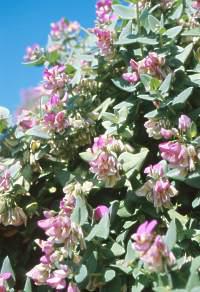Polygala fruticosa 'Southern Shores'
Polygala fruticosa 'Southern Shores' P.J.Bergius
Family: Polygalaceae
Common names: 'Southern Shores' butterfly bush, heart-leaf polygala (Eng.); 'Southern Shores' ertjieblom (Afr.); ulopesi, ulapesi, umabalabala (Xho.); ithethe (Zul.)
Introduction
Many people are familiar with the hardy coastal shrub, Polygala myrtifolia which is useful addition to indigenous gardens. Kirstenbosch staff have now selected a form of Polygala fruticosa, a similar species, which makes an even better garden plant. This selected form has been given the name 'Southern Shores'.

The original plant was found growing out of rocky fissures so close to the sea that the plants were being splashed with salt water at high tide. What attracted us was the unusually compact growth habit, the pointed, heart-shaped, blue-green leaves and the masses of intensely purple flowers. Plants grown at Kirstenbosch have retained this lovely compact growth habit and leaf colour.
Description
Description
Polygala fruticosa 'Southern Shores' is a neat, rounded shrub up to 1 m tall. The young leaves of this indigenous evergreen are tinged with purple, the shade echoed by the deep purple, winged flowers. Peak displays of flowers occur from spring to early summer, giving an unequalled show. It also produces a scattering of blooms throughout the year. Bees are particularly attracted to the nectar that the flowers produce and are the main pollinators. Seeds are enclosed in papery, flattened capsules that remain on the bush for quite some time during and after flowering.

The truly lovely flowers superficially resemble those of the pea and legume family but are actually quite different. All members of this genus have three to five sepals and three to five petals. The two lateral sepals are petal-like, larger than the others, coloured like the petals, and resemble the wing petals of a pea flower. The lower petal is boat-shaped and encloses the eight stamens and the style, and resembles the keel of a pea flower. A characteristic of all polygalas that makes them easily distinguishable from the pea is the brush-like tuft on the lower, keel-like petal. Closer inspection also reveals that the flowers do not have a large standard petal (also called the banner) like pea flowers do. Another distinguishing difference is that polygalas do not bear leguminous fruit.

Distribution and habitat
Distribution description
Polygala fruticosa is a native of South Africa, growing on mountain slopes and coastal hills from the southern Cape to the Karoo and KwaZulu-Natal. It tolerates a range of soils, from clay to rocky sandstone.
Members of the family Polygalaceae occur nearly world-wide in 17 genera, with 950 species. Of the 400-450 southern African species, 32 occur in the Cape region. The genus Polygala consists of about 600 species that occur in temperate and warm regions of the world. There are 232 species of Polygala in Africa and Madagascar, approximately 88 of which occur in southern Africa.
Derivation of name and historical aspects
History
The name Polygala is derived from classical Greek polys meaning much and gala meaning milk, so named because the plants were believed to enhance milk production in livestock. The specific name fruticosa means shrubby or bushy in Latin. The family name Polygalaceae is known as the milkwort family / false legume family/ butterfly bush family.
Growing Polygala fruticosa 'Southern Shores'
Grow
This hardy plant requires no special care. Good, enriched soil, full sun or semi-shade and plenty of water, will ensure rapid, healthy growth. It has excellent waterwise properties, and once established it will tolerate fairly heavy drought.
It is ideal as a specimen plant grown to brighten up any patch in your garden. It is a lovely container plant and it will also do well in a mixed border, providing attractive flowers and/or foliage all year round. The 'Southern Shores' selection grows very well in rockeries, on slopes, terraforce walls and any well-drained, sunny garden position providing a beautiful display. As it grows naturally next to the sea it is also an ideal small shrub for coastal gardens.
Polygala fruticosa is freely self-seeding and small plants will appear around the parent plant after the first flowering season, and these will transplant easily. Seed is typical of Polygala being a small, hard, oval, black seed. Treat seed with hot water for better germination. Light scarification and treatment with pre-emergence fungicide will give optimum results, but is not necessary for good germination.
Polygala fruticosa can also be propagated vegetatively using tip or heel cuttings, preferably taken during spring or autumn.
Pruning is not necessary as it retains a compact habit, but when cultivated in bags they may be pruned and will readily resprout from medium to hard pruning done on the young wood.
Other recommended species are:
Polygala myrtifolia, the September butterfly bush, is a hardy, quick-growing coastal shrub with lime-green leaves producing masses of purple-pink flowers, mainly from spring to summer.

Polygala virgata, purple broom, is a sparse shrub with arching branches, bearing graceful sprays of deep purplish pink flowers.

Credits
Cherise Viljoen and Anthony Hitchcock
Kirstenbosch Botanical Garden
October 2002
Plant Attributes:
Plant Type: Shrub
SA Distribution:
Soil type: Sandy, Clay, Loam
Flowering season: Spring, Early Summer, Winter, Sporadic/All year
PH: Acid, Neutral
Flower colour: Purple, Pink
Aspect: Full Sun, Afternoon Sun (Semi Shade)
Gardening skill: Easy
Special Features:
Horticultural zones










Rate this article
Article well written and informative
Rate this plant
Is this an interesting plant?
Login to add your Comment
Back to topNot registered yet? Click here to register.